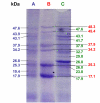Insulinotropic and anti-inflammatory effects of rosiglitazone in experimental autoimmune diabetes
- PMID: 17491689
- PMCID: PMC1783562
- DOI: 10.1900/RDS.2005.2.146
Insulinotropic and anti-inflammatory effects of rosiglitazone in experimental autoimmune diabetes
Abstract
Cytokines and nitric oxide (NO) are involved in the pathogenesis of autoimmune diabetes mellitus (DM). Rosiglitazone is an insulin-sensitizing drug that is a ligand for the nuclear receptor peroxisome proliferator-activated receptor-gamma (PPAR-gamma). The anti-inflammatory and immunomodulating properties of PPAR-gamma have been documented. The aim of this study is to investigate the effectiveness of rosiglitazone in autoimmune DM and to clarify the possible mechanism(s) involved. Autoimmune DM was induced in adult male Balb/c mice by co-administration of cyclosporin A and multiple low doses of streptozotocin. Diabetic mice were treated daily with rosiglitazone (7 mg/kg, p.o.) for 21 days. Blood glucose level (BGL), serum insulin level and pancreatic levels of tumor necrosis factor-alpha (TNF-alpha), interferon-gamma (IFN-gamma) and NO were measured. Histopathological examination and immunohistochemical determination of CD4 and CD8 T lymphocytes in the pancreatic islets were performed. In addition, analysis of pancreatic protein expression was carried out. The results showed that rosiglitazone treatment resulted in a significant decrease in the BGL and the pancreatic levels of TNF-alpha, IFN-gamma and NO compared to diabetic mice. The serum insulin level was significantly increased after rosiglitazone treatment compared to diabetic mice. The destroyed pancreatic islets were regenerated and became free from both CD4 and CD8 T cells after treatment. Furthermore, many changes in pancreatic protein expression were observed. These results suggest that rosiglitazone has a beneficial effect in the treatment of autoimmune diabetes, an effect that seemed to be a secondary consequence of its anti-inflammatory and immunomodulating properties and might be reflected at the level of protein expression.
Figures








Similar articles
-
Effect of Rosiglitazone, the Peroxisome Proliferator-Activated Receptor (PPAR)-γ Agonist, on Apoptosis, Inflammatory Cytokines and Oxidative Stress in pentylenetetrazole-Induced Seizures in Kindled Mice.Neurochem Res. 2023 Sep;48(9):2870-2880. doi: 10.1007/s11064-023-03951-7. Epub 2023 May 19. Neurochem Res. 2023. PMID: 37204549
-
Attenuation of islet-specific T cell responses is associated with C-peptide improvement in autoimmune type 2 diabetes patients.Clin Exp Immunol. 2013 Feb;171(2):164-70. doi: 10.1111/cei.12012. Clin Exp Immunol. 2013. PMID: 23286943 Free PMC article. Clinical Trial.
-
Peripheral cytokine expression in autoimmune thyroiditis: effects of in vitro modulation by rosiglitazone and dexamethasone.Thyroid. 2006 Oct;16(10):953-60. doi: 10.1089/thy.2006.16.953. Thyroid. 2006. PMID: 17042679
-
Peroxisome proliferator-activated receptor gamma agonist improves arterial stiffness in patients with type 2 diabetes mellitus and coronary artery disease.Metabolism. 2007 Oct;56(10):1396-401. doi: 10.1016/j.metabol.2007.05.011. Metabolism. 2007. PMID: 17884451 Clinical Trial.
-
[Effects of rosiglitazone on peroxisome proliferator activated receptor-γ pathway in patients with chronic obstructive pulmonary disease].Zhonghua Jie He He Hu Xi Za Zhi. 2011 Oct;34(10):743-8. Zhonghua Jie He He Hu Xi Za Zhi. 2011. PMID: 22321707 Chinese.
Cited by
-
PPARγ Agonists in Adaptive Immunity: What Do Immune Disorders and Their Models Have to Tell Us?PPAR Res. 2013;2013:519724. doi: 10.1155/2013/519724. Epub 2013 Aug 1. PPAR Res. 2013. PMID: 23983678 Free PMC article.
-
Differential transcriptional expression of PPARalpha, PPARgamma1, and PPARgamma2 in the peritoneal macrophages and T-cell subsets of non-obese diabetic mice.J Clin Immunol. 2009 Sep;29(5):595-602. doi: 10.1007/s10875-009-9300-1. Epub 2009 May 27. J Clin Immunol. 2009. PMID: 19472040
-
Rosiglitazone modulates insulin-induced plasma membrane area changes in single 3T3-L1 adipocytes.J Membr Biol. 2008 Jun;223(3):141-9. doi: 10.1007/s00232-008-9120-x. Epub 2008 Aug 27. J Membr Biol. 2008. PMID: 18754069
References
-
- Gepts W, In't Veld PA. Islet morphological changes. Diabetes Metab Rev. 1987;3:859–872. - PubMed
-
- Rabinovitch A. In: Le Roith D, Taylor SI, Olefsky JM. Diabetes Mellitus a Fundamental and Clinical Text. 2000. Role of cell-mediated immunity and cytokines in the pathogenesis of type 1 diabetes mellitus; pp. 383–398.
-
- Rabinovitch A, Suarez-Pinzon WL. Role of cytokines in the pathogenesis of autoimmune diabetes mellitus. Rev Endocr Metab Disord. 2003;4:291–299. - PubMed
-
- Major CD, Gao ZY, Wolf BA. Activation of the sphingomyelinase/ceramide signal transduction pathway in insulin-secreting beta-cells: role in cytokine induced beta-cell death. Diabetes. 1999;48:1372–1380. - PubMed
-
- Lehmann PV, Sercerz EE, Forsthuber T, Dayan CM, Gammon G. Determinant spreading and the dynamics of the autoimmune T cell repertoire. Immunol Today. 1993;14:203–207. - PubMed
LinkOut - more resources
Full Text Sources
Research Materials
